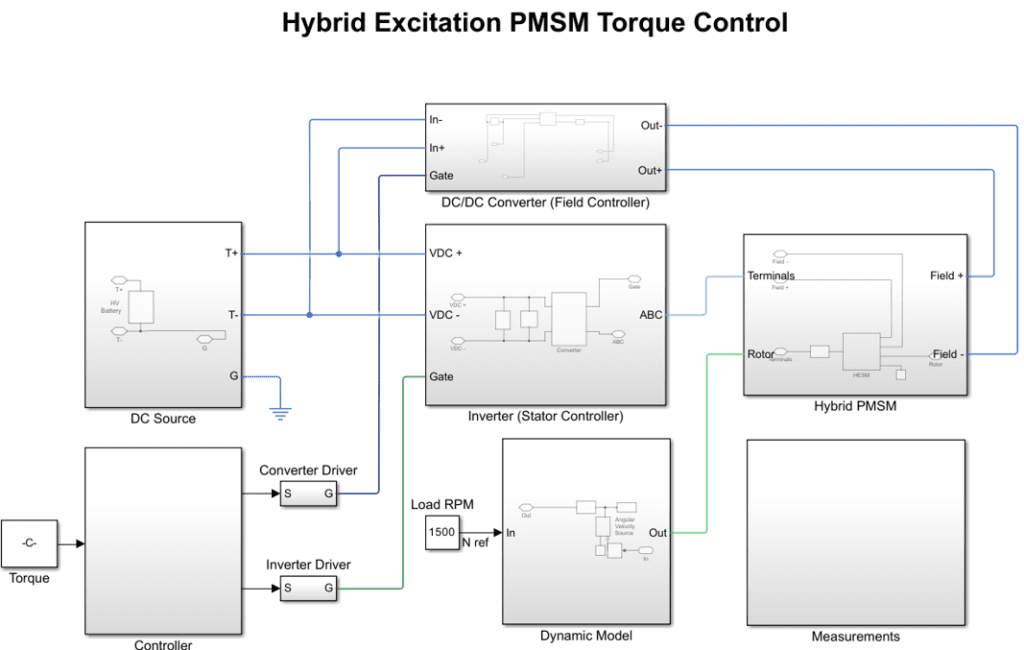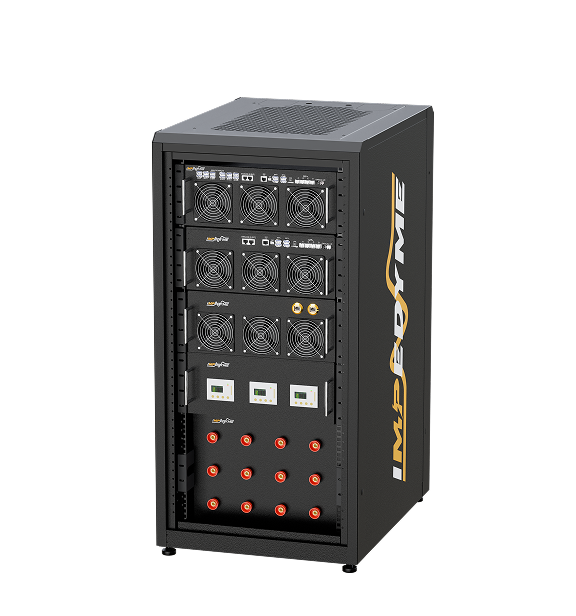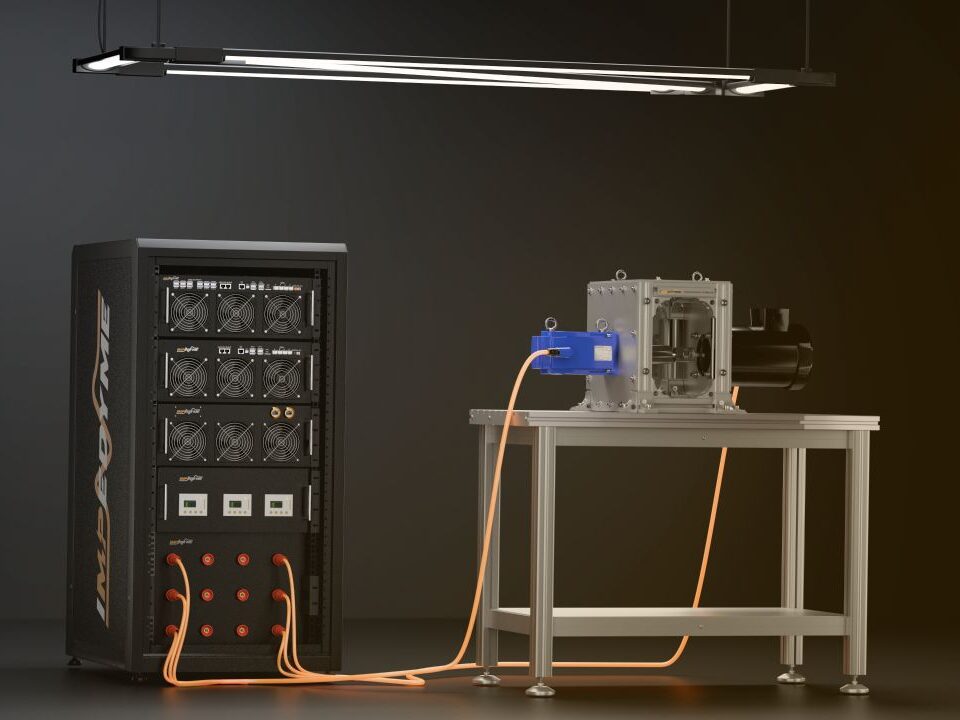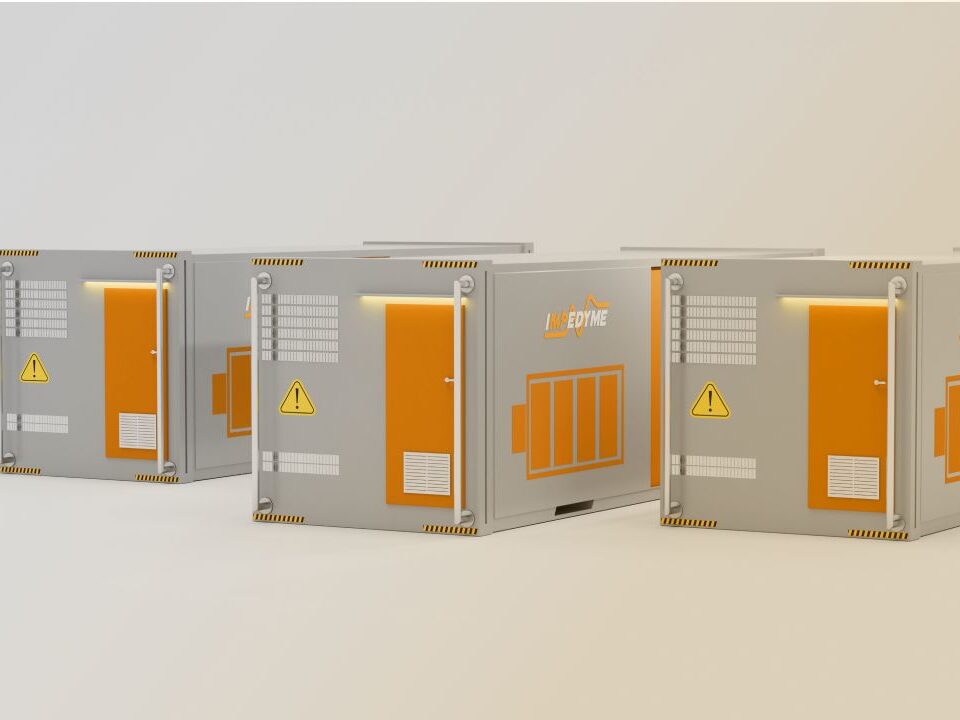
-
 Induction Motor
Induction Motor
-
 Automotive Electrical System Simulation
Automotive Electrical System Simulation
-
 DC/DC Bidirectional Converter
DC/DC Bidirectional Converter
-
 PWM Control for Brushless DC
PWM Control for Brushless DC
-
 BLDC Motor Control and Drive Simulation
BLDC Motor Control and Drive Simulation
-
 Electric Vehicle Fast Charger Simulation
Electric Vehicle Fast Charger Simulation
-
 DFIG Wind Turbine Simulation
DFIG Wind Turbine Simulation
-
 Dual Active Bridge
Dual Active Bridge
-
 EV Dynamometer Test Environment Simulation
EV Dynamometer Test Environment Simulation
-
 Electric Vehicle Simulation
Electric Vehicle Simulation
-
 Three-Phase Grid-Connected Inverter Using Direct-Q…
Three-Phase Grid-Connected Inverter Using Direct-Q…
-
 Three-Phase Grid-Connected Solar Photovoltaic
Three-Phase Grid-Connected Solar Photovoltaic
-
 Grid-Connected Rectifier
Grid-Connected Rectifier
-
 Grid-Tied Inverter System
Grid-Tied Inverter System
-
 Torque Control in a Hybrid Excitation Synchronous …
Torque Control in a Hybrid Excitation Synchronous …
-
 Wye-Delta Starting Circuit
Wye-Delta Starting Circuit
-
 IPMSM-Based Axle-Drive
IPMSM-Based Axle-Drive
-
 Simplified Parallel Hybrid Electric Vehicle
Simplified Parallel Hybrid Electric Vehicle
-
 Simplified Series Hybrid Electric Vehicle
Simplified Series Hybrid Electric Vehicle
-
 Series-Parallel Hybrid Electric Vehicle
Series-Parallel Hybrid Electric Vehicle
-
 Three-Phase Matrix Converter Simulation
Three-Phase Matrix Converter Simulation
-
 Venturini Modulation for Three-Phase Matrix Conver…
Venturini Modulation for Three-Phase Matrix Conver…
-
 Microgrid Frequency Regulation Using Vehicle-to-Gr…
Microgrid Frequency Regulation Using Vehicle-to-Gr…
-
 Three-Phase Modular Multilevel Converter
Three-Phase Modular Multilevel Converter
-
 Field-Oriented Control
Field-Oriented Control
-
 Interior Permanent Magnet Synchronous Generator
Interior Permanent Magnet Synchronous Generator
-
 Permanent Magnet Synchronous Machine
Permanent Magnet Synchronous Machine
-
 PMSM Rotor Angular Velocity
PMSM Rotor Angular Velocity
-
 PMSM-Based Electrical Traction Drive
PMSM-Based Electrical Traction Drive
-
 Maximum Power Point Tracking
Maximum Power Point Tracking
-
 Six-Phase Permanent Magnet Synchronous Machine
Six-Phase Permanent Magnet Synchronous Machine
-
 Synchronous Machine-Based Electrical Drive Simulat…
Synchronous Machine-Based Electrical Drive Simulat…
-
 Single-Stage Solar Inverter
Single-Stage Solar Inverter
-
 Three-Phase Cycloconverter Simulation
Three-Phase Cycloconverter Simulation
-
 Totem-Pole PFC Simulation
Totem-Pole PFC Simulation
-
 Twelve-Pulse Thyristor Rectifier
Twelve-Pulse Thyristor Rectifier
-
 Two-Wheeler On-Board Charger
Two-Wheeler On-Board Charger
-
 Vienna Rectifier Simulation
Vienna Rectifier Simulation
-
 High-Voltage Direct Current
High-Voltage Direct Current
-
 Wireless Power Transfer
Wireless Power Transfer

Comprehensive Documentation for Torque Control in a Hybrid Excitation Synchronous Machine (HESM) for Electric Traction
Table of Contents
- 1 Comprehensive Documentation for Torque Control in a Hybrid Excitation Synchronous Machine (HESM) for Electric Traction
- 1.1 Introduction
- 1.2 System Overview
- 1.2.1 What is a Hybrid Excitation Synchronous Machine (HESM)?
- 1.2.2 Purpose of the Simulation
- 1.3 Key Features
- 1.3.1 Dual-Mode Excitation Control
- 1.3.2 Advanced Torque Control Strategies
- 1.3.3 Field-Weakening Capability for High-Speed Operation
- 1.3.4 Precise Torque Control
- 1.3.5 High Efficiency
- 1.3.6 Regenerative Braking
- 1.3.7 Flexibility
- 1.4 Simulation Objectives
- 1.5 Technical Description
- 1.5.1 System Configuration
- 1.5.2 Control Methodology
- 1.6 Advantages of HESM for Electric Traction
- 1.7 Applications
- 1.7.1 Railway and Metro Systems
- 1.7.2 Electric Vehicles (EVs)
- 1.7.3 Industrial Machinery
- 1.7.4 Aerospace and Defense
- 1.7.5 Marine and Offshore Applications
- 1.7.6 Agricultural and Construction Equipment
- 1.7.7 Material Handling and Logistics
- 1.7.8 Research and Development
- 1.8 Simulation Benefits
- 1.9 Summary
- 1.10 Future Enhancements
- 1.10.1 Induction Motor
- 1.10.2 Automotive Electrical System Simulation
- 1.10.3 DC/DC Bidirectional Converter
- 1.10.4 PWM Control for Brushless DC
Introduction
This project focuses on torque control in a Hybrid Excitation Synchronous Machine (HESM) for electric traction applications. The HESM utilizes a dual excitation mechanism, combining permanent magnets (PMs) and an excitation winding, enabling improved flux control and operational flexibility. By optimizing torque production and flux regulation, this simulation provides insights into efficient control strategies for traction motor applications in electric vehicles (EVs) and railway systems.

System Overview
What is a Hybrid Excitation Synchronous Machine (HESM)?
A Hybrid Excitation Synchronous Machine (HESM) is a type of synchronous motor that integrates both permanent magnets (PMs) and a separately controlled excitation winding. This structure provides dynamic control over the air-gap flux, enabling:
- Wide-speed operation with field-weakening capability.
- Improved efficiency over conventional PM and wound-field synchronous machines.
- Better torque control for electric traction applications.
Purpose of the Simulation
The simulation aims to:
- Analyze torque production and flux regulation across different speed ranges.
- Evaluate direct torque control (DTC) and field-oriented control (FOC) strategies.
- Optimize efficiency and operational flexibility for electric traction.
Key Features
Dual-Mode Excitation Control
By adjusting the excitation winding current, the flux can be controlled dynamically.
➡️ HIL/PHIL Benefit: Allows real-time tuning of excitation strategies for efficiency optimization.
Advanced Torque Control Strategies
The simulation supports:
- Field-Oriented Control (FOC): Decoupled control of torque and flux for precise performance.
- Direct Torque Control (DTC): Fast dynamic response without the need for current loops.
➡️ HIL/PHIL Benefit: Enables real-world evaluation of control strategies before hardware implementation.
Field-Weakening Capability for High-Speed Operation
The machine can adjust its flux at high speeds to avoid excessive back EMF.
➡️ HIL/PHIL Benefit: Allows real-time assessment of field-weakening efficiency in electric traction applications.
Precise Torque Control
HESMs provide precise and smooth torque control, improving performance and efficiency in electric traction systems.
High Efficiency
HESMs combine the advantages of PMSMs and WRSMs, offering high efficiency and flexible excitation control.
Regenerative Braking
Torque control enables efficient energy recovery during braking, improving overall energy efficiency.
Flexibility
HESMs can operate under a wide range of conditions, making them suitable for various industrial applications.
Simulation Objectives
This simulation helps evaluate:
- The effectiveness of torque and flux control methods.
- Dynamic performance of the HESM under varying load and speed conditions.
- Energy efficiency improvements for electric traction applications.
➡️ HIL/PHIL Benefit: Enables real-time validation before deployment in traction systems.
Technical Description
System Configuration
- Input: DC power supply or battery system for EV applications.
- Output: Controlled torque and speed via an inverter-fed HESM.
- Power Stage: IGBT/MOSFET-based three-phase inverter.
Control Methodology
- Torque Control: Implemented via FOC and DTC strategies.
- Flux Regulation: Achieved through excitation current adjustment.
- Modulation Techniques: Space Vector PWM (SVPWM) for smooth inverter switching.
➡️ HIL/PHIL Benefit: Supports real-time implementation of different control algorithms.
Advantages of HESM for Electric Traction
- Improved Efficiency: Optimal flux control reduces losses.
- Wide Speed Range: Field-weakening capability allows high-speed operation.
- Higher Torque Density: Better performance compared to traditional synchronous machines.
➡️ HIL/PHIL Benefit: Enables precise tuning of control parameters for real-world applications.
Applications
Railway and Metro Systems
Electric Trains: HESMs are used in electric locomotives and metro trains for efficient traction and regenerative braking. Torque control ensures smooth operation and energy recovery during braking.
Light Rail and Trams: HESMs provide precise torque control for light rail and tram systems, improving energy efficiency and passenger comfort.
Electric Vehicles (EVs)
Passenger Cars: HESMs with torque control are used in electric cars to provide smooth acceleration, regenerative braking, and efficient power conversion. Simulations optimize torque control algorithms for improved performance and energy efficiency.
Commercial Vehicles: Electric buses, trucks, and delivery vans use HESMs for reliable and efficient traction, especially in stop-and-go urban driving conditions.
Industrial Machinery
Electric Forklifts: HESMs with torque control are used in electric forklifts for precise load handling and efficient operation in warehouses and factories.
Conveyor Systems: HESMs provide reliable torque control for conveyor systems in manufacturing and logistics, ensuring smooth material handling.
Aerospace and Defense
Electric Aircraft: HESMs are used in electric and hybrid aircraft for propulsion and auxiliary systems. Torque control ensures efficient and reliable operation under varying flight conditions.
Military Vehicles: Electric and hybrid military vehicles use HESMs for traction, providing high torque and efficiency in challenging terrains.
Marine and Offshore Applications
Electric Ships: HESMs are used in electric and hybrid ships for propulsion and auxiliary systems. Torque control ensures efficient operation and energy recovery during braking.
Underwater Vehicles: HESMs provide precise torque control for remotely operated vehicles (ROVs) and autonomous underwater vehicles (AUVs), enabling efficient and reliable operation.
Agricultural and Construction Equipment
Electric Tractors: HESMs with torque control are used in electric tractors for efficient and precise operation in agricultural applications.
Electric Excavators: HESMs provide reliable torque control for electric excavators, improving energy efficiency and performance in construction sites.
Material Handling and Logistics
Automated Guided Vehicles (AGVs): HESMs are used in AGVs for precise torque control, ensuring efficient and reliable operation in warehouses and factories.
Cranes and Hoists: HESMs provide reliable torque control for cranes and hoists, improving safety and efficiency in material handling.
Research and Development
Prototype Testing: Simulations are used to test and validate HESM prototypes, reducing the need for physical testing and accelerating development.
Control Strategy Development: Simulations help develop and optimize torque control algorithms for HESMs, ensuring efficient and reliable operation.
Fault Analysis: Simulations help study the behavior of HESMs under fault conditions, improving system reliability and safety.
➡️ HIL/PHIL Benefit: Ensures real-time simulation of diverse applications before hardware deployment.
Simulation Benefits
With this simulation, users can:
- Analyze torque dynamics and flux control efficiency.
- Compare FOC and DTC performance for optimal selection.
- Optimize excitation strategies for energy-efficient operation.
➡️ HIL/PHIL Benefit: Provides hardware-level validation before real-world implementation.
Summary
The Torque Control in a Hybrid Excitation Synchronous Machine (HESM) Simulation provides a detailed framework for studying torque control strategies, flux regulation, and efficiency optimization. Impedyme’s HIL and PHIL solutions enhance the development process:
| Development Stage | Impedyme’s Contribution |
|---|---|
| Torque Control Design | HIL-based validation of FOC and DTC algorithms |
| Flux Regulation Testing | PHIL with real excitation control implementation |
| Field-Weakening Assessment | Real-time evaluation of high-speed operation |
| Energy Efficiency Optimization | Simulation-based tuning for traction applications |
Future Enhancements
- Integration of AI-based adaptive control for real-time torque optimization.
- Development of predictive maintenance models using machine learning.
- Implementation of multi-objective optimization for efficiency and performance trade-offs.
The Torque Control in a Hybrid Excitation Synchronous Machine (HESM) Simulation provides a comprehensive platform for optimizing motor efficiency, enhancing performance, and validating advanced control strategies. With Impedyme’s HIL/PHIL solutions, engineers can fine-tune torque control methods, improve energy efficiency, and ensure seamless integration into electric traction systems.






